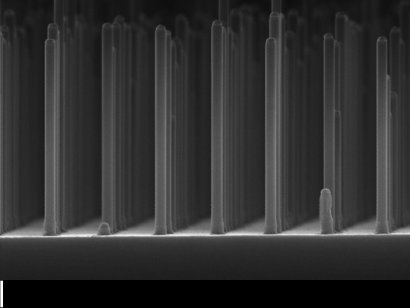Eindhoven University of Technology (Technische Universiteit Eindhoven, or TU/e) and FOM Foundation have presented a prototype of a solar cell that produces fuel rather than electricity (Anthony Standing et al., 'Efficient water reduction with gallium phosphide nanowires', Nature Communications; DOI: 10.1038/nscomms8824).
The electricity produced by a solar cell can be used to set off chemical reactions, which can generate a fuel (a 'solar fuel' – as a promising replacement for polluting fuels). One possibility is to split liquid water using the electricity that is generated (electrolysis). As well as oxygen, the hydrogen gas that is produced can be used as a clean fuel in the chemical industry or combusted in fuel cells (e.g. in cars) to drive engines.
Solar fuel cell
To connect an existing silicon solar cell to a battery that splits water may be an efficient solution now but it is a very expensive one. Many researchers are therefore seeking a material that can both convert sunlight into an electrical charge and split the water, all in one. TU/e and FOM see gallium phosphide (GaP) as the ideal candidate.
Tenfold boost
GaP has good electrical properties but it cannot easily absorb light when it is a large flat surface, as used in GaP solar cells. The researchers overcame this problem by making a grid of very small GaP nanowires (500nm long and 90nm wide). This immediately boosted the yield of hydrogen by a factor of ten, to 2.9%. This is a record for GaP cells, but still well below the 15% achieved by silicon cells coupled to a battery.
Picture: Array of GaP nanowires. Photo: Eindhoven University of Technology.

Ten thousand times less material
According to research leader and TU/e professor Erik Bakkers, it is not simply about the yield – where there is still a lot of scope for improvement. "For the nanowires, we needed 10,000 [times] less precious GaP material than in cells with a flat surface. That makes these kinds of cells potentially a great deal cheaper," Bakkers says. "In addition, GaP is also able to extract oxygen from the water – so you then actually have a fuel cell in which you can temporarily store your solar energy," he adds.
The research was performed within the BioSolar Cells program jointly funded by FOM Foundation, NWO (Netherlands Organization for Scientific Research) and the Ministry of Economic Affairs.





